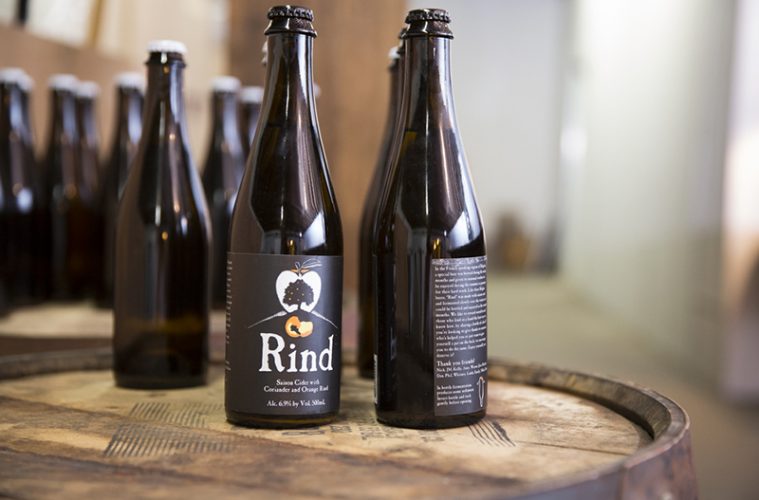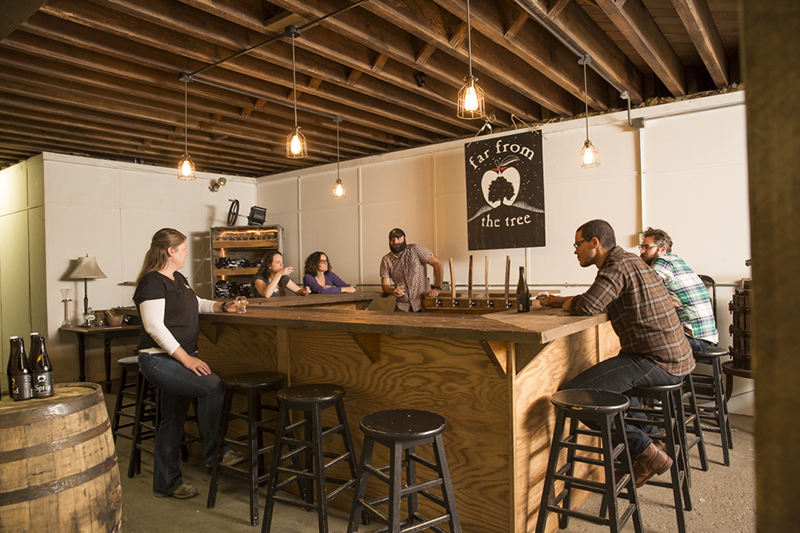There’s a circle of confusion that begins whenever Al Snape tells others about the two-syllable word he spends his days making: cider. “Instantly, they think of sweet cider,” he says. So, it’s like beer? they ask. “Well, not really. It’s more like wine with apples instead of grapes.” Oh. So it’s like wine? “Well, no. It’s cider.”
Even if you have guzzled a bottle of hard cider, chances are it tasted nothing like what Al and his wife, Denise, are offering with Far From The Tree Cider. After three years on the other side of the Atlantic, the Snapes came back home in 2013 with a different impression of what hard cider could be: dry, subtle, and nuanced in ways that its sticky-sweet counterparts are not. All that’s left to do now is clear up the misunderstandings, one taste at a time.
Far From The Tree’s nerve center is an unmarked brick building on Jackson Street in Salem, a long-gone slaughterhouse measuring some 3,000 square feet. The main room is now full of cases of cider bottles, stacked shoulder high underneath a ceiling supported by ultra-thick old-growth beams, and adjacent to a dimly lit bar made of wood reclaimed from a 19th-century Martha’s Vineyard schoolhouse. Behind the bar, there’s a homemade draught system connected to Far From The Tree’s three inaugural ciders. New zoning rules allow the space to be used as Far From the Tree’s tasting room, which is open to the public. It is here that Denise, dressed in business casual, Al with a bushy beard that he says is actually tame right now—sit on stools and explain what’s going on next door in the barrel room, an old freezer unit stocked with more than 100 repurposed bourbon barrels. Some are positioned vertically, full of what’s left of their first 5,000-gallon haul of apple juice from last autumn. Some lay horizontal, empty vessels for the harvest to come.
Up through the 19th century, hard cider was among the most common beverages in New England. These days, it’s a burgeoning niche among alcoholic beverages. While it only accounts for about one percent of its market, hard cider production grew to 32 million gallons in 2013—more than triple the 9.4 million gallons produced just two years earlier.
Instead of commerce, the Snapes’ entry into cider making sprang from wanderlust. In 2010, Denise and Al were both living and working in Boston—Al managed radioactive waste at an MIT lab, while Denise was a project manager for Shire Pharmaceuticals. Al hadn’t lived outside Massachusetts, and Denise had only traveled once out of the country, but their restlessness sent them abroad. Denise took a job with her company overseas in England, while Al took a student visa, enrolling in a Bachelor’s degree program in oenology and viticulture at Plumpton College, an affiliate of the University of Brighton. It was a natural fit: Al and Denise had already been making wine in their South Boston apartment. “I was literally spending half the day at my old job online looking at wine and grape varieties anyway,” Al says.
|
The real revelation came after-hours. “We had never tried European ciders before we moved to England,” Denise says. “I wasn’t really into the warm cask ales in the pubs, but there were always two or three cider options.” They discovered that the ciders were something entirely different than they were stateside, less Mike’s Hard Lemonade and more dry Champagne. The cider-making process overlapped with Al’s education—apples are essentially “big, hard grapes,” he says. In the middle of his dissertation—about the tribulations of growing Riesling grapes in cold New England-esque climates—Al had an epiphany: “What’s the point of all that work when you can just plant an apple tree?”
Upon their return to the United States, the Snapes flirted with the idea of moving out west and opening their own cider business. “The cider industry in Oregon, Washington, and California is so prominent, but if we moved to the West Coast, it’s just like being in England, so far away from home,” Denise says. Instead, they returned to Massachusetts in July 2013, found the old slaughterhouse on Jackson Street, painted the walls, and started sprucing up the place. With the help of a few friends, Far From The Tree began making its first batch of cider a few months later.
The cider-making process isn’t so far off from winemaking, and it begins with the apples. Most are Cortlands, selected for their acidity, sugar, and tannins, and all come from orchards in central Massachusetts and are pressed into juice at Box Mill Farm in Stow. Al hauls the juice back in a truck, pumps it into the barrel room, and the fermentation process begins. While sweeter mainstream ciders ferment quickly and at high temperatures, each barrel of Far From The Tree’s cider ferments over a span of six to eight months at temperatures hovering around 50 degrees Fahrenheit. The process results in the characteristic dryness and relatively high alcohol content. (The 6.9percent alcohol by volume is one of the reasons why the Snapes serve their cider in brandy glasses instead of pints.)
Subtle variations in the process culminated in Far From The Tree’s first three varietals, which came to market in 16-ounce bottles last May. Roots, the flagship cider, resonates with hints of oak from the bourbon barrels and maple syrup sourced from a farm in western Massachusetts. Rind is a citrusy, year-round cider made with saison yeast, coriander, and orange rind. Sprig, a summer varietal, is dry-hopped with cascade hops and finished with fresh mint before bottling.
Far From The Tree Cider is available at bars, restaurants, and liquor stores across the North Shore and Boston. Since first releasing their cider, the Snapes have been growing audiences through regular visits to the farmers’ markets in Salem and Newburyport, where they can explain the difference between their cider and all the rest. Al and Denise freely admit that their libation isn’t for everyone: wine drinkers expecting something like Zinfandel are in for an entirely different experience with the dryness of Roots or Rind. But often- times, they say, the folks with the most skeptical expressions are the ones most likely to bring home bottles after they’ve had a taste.
A little more than a year into the only business venture they’ve ever known, the Snapes look forward with a mix of excitement and apprehension. Excitement in the face of the possibilities: building a reserve of cider and using different vintages in future batches; planting an orchard within driving distance and reviving rare and exotic apples; and a developing a new holiday varietal due for release this month that’s based on the taste of Joe Froggers cookies. The apprehension stems from one core question: Do people like the same kind of cider we like? The converts aren’t going away, but if they ever do, the Snapes have a backup plan. “If we can’t sell any of it,” Al says, “we’ll just put it all in a basement, and we’ll have enough cider to enjoy forever.” farfromthetreecider.com


 The Snapes recently invested in a new tasting room
The Snapes recently invested in a new tasting room